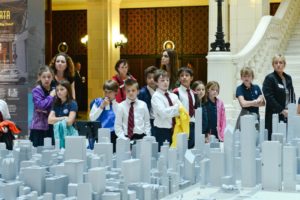By Chris Wilson and Alice Walker
 The model of downtown Chicago that stands in the atrium of the Railway Exchange Building often collects a crowd. Fortunately, a Visitor Experience Volunteer (VEV) is almost always in attendance to assist visitors. VEVs Chris Wilson and Alice Walker noted some of the comments they have overheard.
The model of downtown Chicago that stands in the atrium of the Railway Exchange Building often collects a crowd. Fortunately, a Visitor Experience Volunteer (VEV) is almost always in attendance to assist visitors. VEVs Chris Wilson and Alice Walker noted some of the comments they have overheard.
“This model is amazing. I’m from Chicago, and I didn’t know this existed.”
“The city is so beautiful and so clean.” This comment comes from guests of all ages, from other parts of our country and from abroad.
“Everyone is so friendly and so helpful.”
“We learned so much on our walking tour/boat cruise.” This is usually followed by the comment that they want to sign up for another tour.
“We had a layover in Chicago and decided to spend some time looking around. We HAVE to come back.”
“I’m going on Facebook to tell my friends they have to make a trip to this great city and sign up for the tours.”
Chris and Alice have also observed the following:
Many people will bring guests in and point out where they have lived, where they worked, and the different neighborhoods. (They really enjoyed the large neighborhood map when it was on display.) Often, the model is the most visual way for visitors to orient themselves to the city: “I didn’t realize I was this far down Michigan Avenue” or they use the model…and the red dot on the Railway Exchange Building… to get their bearings as they try to locate their hotel.
For local visitors, the model affords the opportunity to share their knowledge about the city; what they have witnessed over the years as buildings have come down and gone up; and in some cases, the work they have personally contributed as engineers or architects on some of the buildings. One grandmother brought in her grandson and wanted to show him where he had been born. The bad news is that Prentice Women’s Hospital no longer exists; the good news, we were able to pull up a picture on the internet.
The VEVs also have the opportunity to answer guests’ questions about the model: How often do you update the model? What do those shades of grey mean? How is it made to scale? Where is Wrigley Field, Navy Pier, and where do the White Sox play? The challenging part is answering some of their other questions. Here is a sampling:
- How are tall buildings measured?
- I have two hours before I leave for the airport. What can I do and where can I leave my suitcase while I walk around?
- What was the first skyscraper built in Chicago, and where is it on the model?
- What is “the loop” and the “el”?
- Can you help me find the street (and hotel) where I am staying so I know how far I have walked?
- How far down do they have to go to anchor a high rise?
- Do you ever worry that there are too many tall/heavy buildings in one area, and can the ground support all of that weight?
- How deep is the Chicago River?
- What bus/train do I take to the zoo/ the museum campus/ the Museum of Science and Industry?
- Why was a modern building like the Spertus Institute allowed in the Michigan Ave street wall?
As you may have guessed, the most frequently asked question is “Where is the bathroom?”

